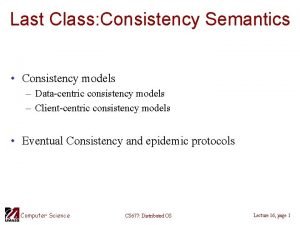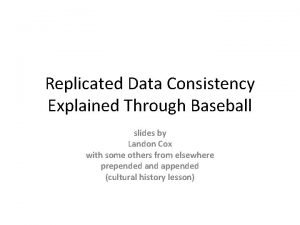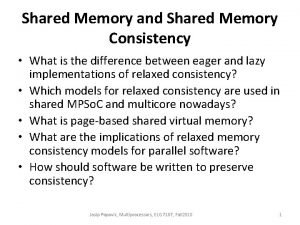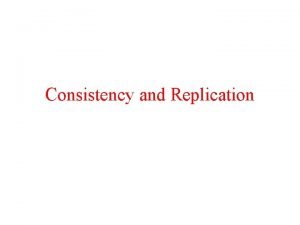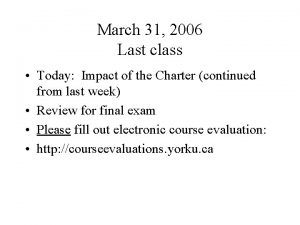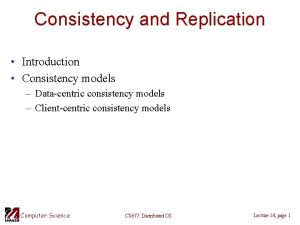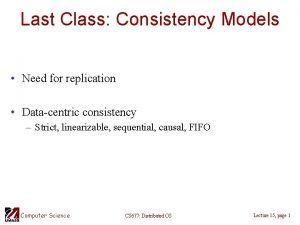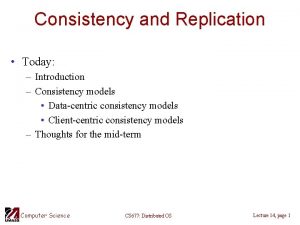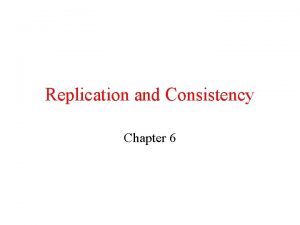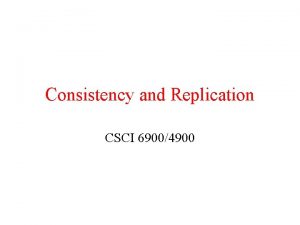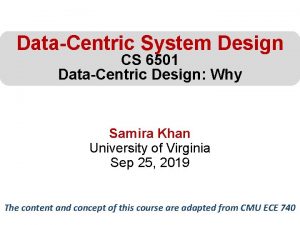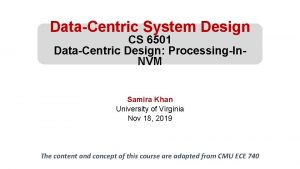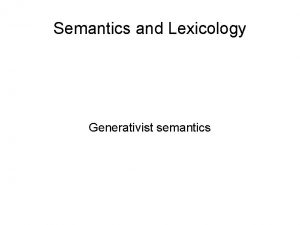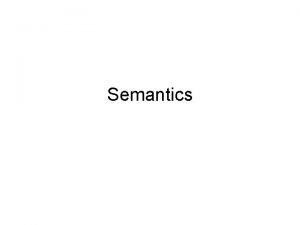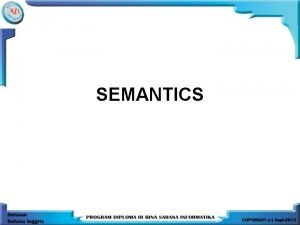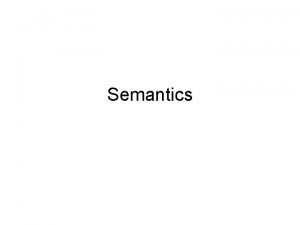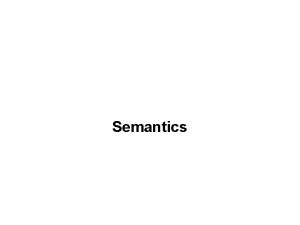Last Class Consistency Semantics Consistency models Datacentric consistency


















- Slides: 18

Last Class: Consistency Semantics • Consistency models – Data-centric consistency models – Client-centric consistency models • Eventual Consistency and epidemic protocols Computer Science CS 677: Distributed OS Lecture 16, page 1

Today: More on Consistency • Consistency protocols – Primary-based – Replicated-write • Putting it all together – Final thoughts • Fault-tolerance Introduction • Project 2 Computer Science CS 677: Distributed OS Lecture 16, page 2

Implementation Issues • Two techniques to implement consistency models – Primary-based protocols • Assume a primary replica for each data item • Primary responsible for coordinating all writes – Replicated write protocols • No primary is assumed for a data item • Writes can take place at any replica Computer Science CS 677: Distributed OS Lecture 16, page 3

Remote-Write Protocols • Traditionally used in client-server systems Computer Science CS 677: Distributed OS Lecture 16, page 4

Remote-Write Protocols (2) • Primary-backup protocol – Allow local reads, sent writes to primary – Block on write until all replicas are notified – Implements sequential consistency Computer Science CS 677: Distributed OS Lecture 16, page 5

Local-Write Protocols (1) • Primary-based local-write protocol in which a single copy is migrated between processes. – Limitation: need to track the primary for each data item Computer Science CS 677: Distributed OS Lecture 16, page 6

Local-Write Protocols (2) • Primary-backup protocol in which the primary migrates to the process wanting to perform an update Computer Science CS 677: Distributed OS Lecture 16, page 7

Replicated-write Protocols • Relax the assumption of one primary – No primary, any replica is allowed to update – Consistency is more complex to achieve • Quorum-based protocols – Use voting to request/acquire permissions from replicas – Consider a file replicated on N servers – Update: contact at least (N/2+1) servers and get them to agree to do update (associate version number with file) – Read: contact majority of servers and obtain version number • If majority of servers agree on a version number, read Computer Science CS 677: Distributed OS Lecture 16, page 8

Gifford’s Quorum-Based Protocol • a) b) c) Three examples of the voting algorithm: A correct choice of read and write set A choice that may lead to write-write conflicts A correct choice, known as ROWA (read one, write all) Computer Science CS 677: Distributed OS Lecture 16, page 9

Final Thoughts • Replication and caching improve performance in distributed systems • Consistency of replicated data is crucial • Many consistency semantics (models) possible – Need to pick appropriate model depending on the application – Example: web caching: weak consistency is OK since humans are tolerant to stale information (can reload browser) – Implementation overheads and complexity grows if stronger guarantees are desired Computer Science CS 677: Distributed OS Lecture 16, page 10

Fault Tolerance • Single machine systems – Failures are all or nothing • OS crash, disk failures • Distributed systems: multiple independent nodes – Partial failures are also possible (some nodes fail) • Question: Can we automatically recover from partial failures? – Important issue since probability of failure grows with number of independent components (nodes) in the systems – Prob(failure) = Prob(Any one component fails)=1 -P(no failure) Computer Science CS 677: Distributed OS Lecture 16, page 11

A Perspective • Computing systems are not very reliable – OS crashes frequently (Windows), buggy software, unreliable hardware, software/hardware incompatibilities – Until recently: computer users were “tech savvy” • Could depend on users to reboot, troubleshoot problems – Growing popularity of Internet/World Wide Web • “Novice” users • Need to build more reliable/dependable systems – Example: what is your TV (or car) broke down every day? • Users don’t want to “restart” TV or fix it (by opening it up) • Need to make computing systems more reliable Computer Science CS 677: Distributed OS Lecture 16, page 12

Basic Concepts • Need to build dependable systems • Requirements for dependable systems – Availability: system should be available for use at any given time • 99. 999 % availability (five 9 s) => very small down times – Reliability: system should run continuously without failure – Safety: temporary failures should not result in a catastrophic • Example: computing systems controlling an airplane, nuclear reactor – Maintainability: a failed system should be easy to repair Computer Science CS 677: Distributed OS Lecture 16, page 13

Basic Concepts (contd) • Fault tolerance: system should provide services despite faults – Transient faults – Intermittent faults – Permanent faults Computer Science CS 677: Distributed OS Lecture 16, page 14

Failure Models Type of failure Description Crash failure A server halts, but is working correctly until it halts Omission failure Receive omission Send omission A server fails to respond to incoming requests A server fails to receive incoming messages A server fails to send messages Timing failure A server's response lies outside the specified time interval Response failure Value failure State transition failure The server's response is incorrect The value of the response is wrong The server deviates from the correct flow of control Arbitrary failure A server may produce arbitrary responses at arbitrary times • Different types of failures. Computer Science CS 677: Distributed OS Lecture 16, page 15

Failure Masking by Redundancy • Triple modular redundancy. Computer Science CS 677: Distributed OS Lecture 16, page 16

Project 2 • Online banking using a distributed database • Database distributed across 3 machines – Set of accounts split across the three disks • Replication: each account is also replicated on a second machine Computer Science CS 677: Distributed OS Lecture 16, page 17

Project 2 • Load balancer/request redirector – All client requests arrive at this component – Forwards the request to an “appropriate” server – Two policies: per-account round-robin, least-loaded • Distributed locks: Ricart and Agarwala algorithm – Can use logical clocks or simplify using physical clocks • Consistency: strict/release, before releasing a lock, propagate changes to replica Computer Science CS 677: Distributed OS Lecture 16, page 18
 Compare procedural semantics and declarative semantics.
Compare procedural semantics and declarative semantics. Consistency in science
Consistency in science Acid vs base
Acid vs base Distributed shared memory architecture tutorialspoint
Distributed shared memory architecture tutorialspoint Monotonic write consistency
Monotonic write consistency Memory consistency
Memory consistency Distributed data store
Distributed data store Consistency is the last refuge of the unimaginative
Consistency is the last refuge of the unimaginative Modals and semi-modals
Modals and semi-modals Ppt on the last lesson
Ppt on the last lesson Last class for today
Last class for today What did we learn last class
What did we learn last class Last class of the day
Last class of the day Noun clauses embedded questions
Noun clauses embedded questions What did we learn last class
What did we learn last class We have class today
We have class today Package mypackage; class first { /* class body */ }
Package mypackage; class first { /* class body */ } Difference between abstract class and concrete class
Difference between abstract class and concrete class Measures of central tendency for grouped data
Measures of central tendency for grouped data

